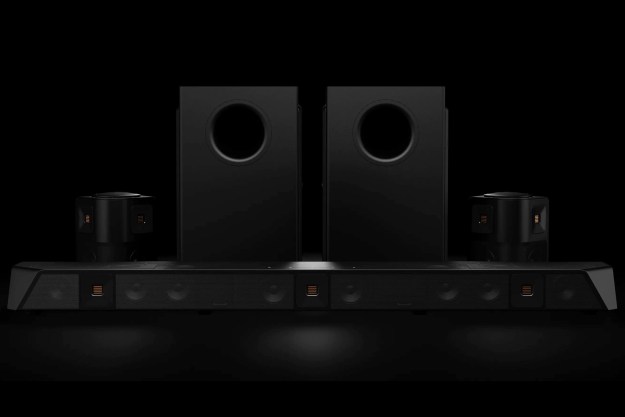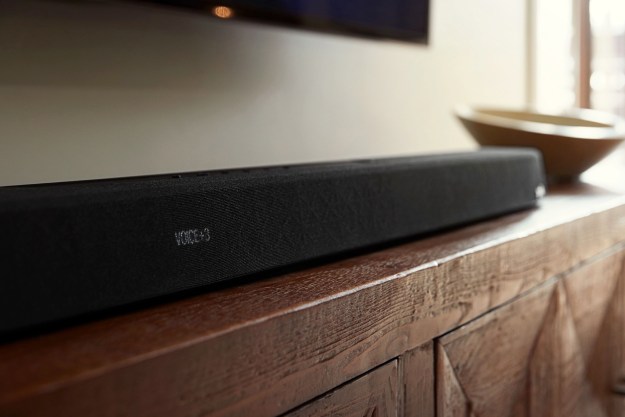
- Simple and easy to use
- Dolby Atmos
- AirPlay
- Chromecast
- No EQ settings
- Bass can't compete with subwoofers
As the soundbar category rapidly grows, with more and more options and prices, there’s a tendency for these devices to get complicated. Wireless subwoofers, satellite surround speakers, and even voice assistants are all part of the mix now, making your purchase decision harder than ever.
The $350 JBL Bar 5.0 Multibeam is, by comparison, relatively simple and affordable, and yet it’s still packed with useful features and solid sound quality. Best of all, it offers one of the easiest ways to dip your toes into Dolby Atmos, the immersive, 3D surround sound format that is rapidly becoming a standard for both streaming movies and streaming music.
Is it the right soundbar for you? Let’s check it out.
What’s in the box?
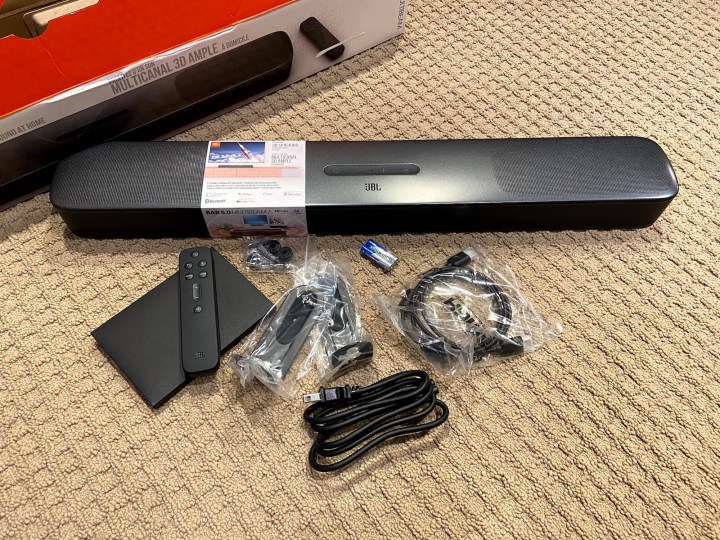
JBL throws in everything you need: The soundbar, a power cable, an HDMI cable, a slender remote with two AA batteries, a set of wall-mount brackets with a mounting template, and a quick-start guide. There’s one small foam wrapper that protects the soundbar, but the majority of the packaging is recyclable.
Design
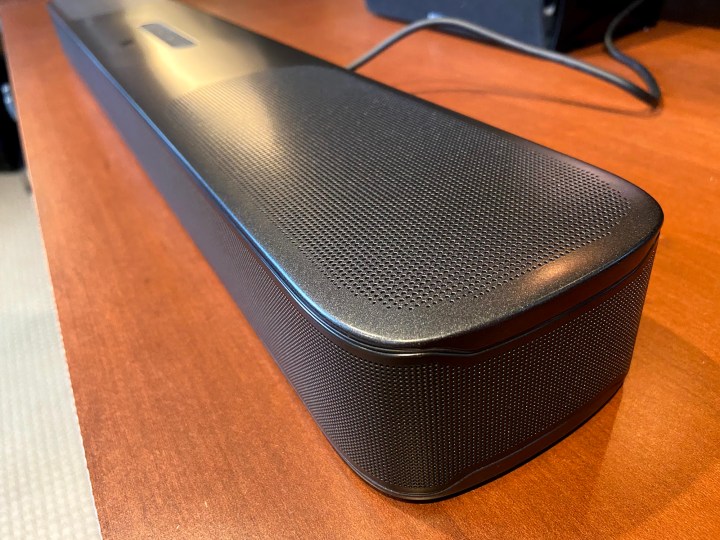
The JBL Bar 5.0 Multibeam is easy to like: At 27.9-inches wide and 2.4-inches tall, it’s very compact for a home theater soundbar and should be able to sit in front of most TVs without obscuring the bottom of the screen.
Its satin-finish black plastic housing disappears entirely when the lights go down and barely draws any attention to itself when the lights are on. To me, that’s the ideal design for a soundbar.
There are four top-mounted controls for power, volume, and source selection, but you’ll likely end up using the included remote most of the time.
Far too many soundbars require that you give up one of your TV’s HDMI ports, but not the Bar 5.0.
Hidden behind the speaker grille is an LED display that actually scrolls full-text messages or numbers so you can see exactly what’s going on (unlike some soundbars from Vizio, which use a series of colored dots). There’s no way to adjust the display’s brightness, but it automatically turns itself off within a few seconds of any settings changes, so it won’t be a distraction while watching your shows or movies.
The remote is a bare-bones affair. Ultra-lightweight, and with only a handful of buttons, it’s easy to use and comfortable to hold.
My only small gripe is that the labels are small and there’s no backlight, so you may have to spend a few moments memorizing what the buttons do so you can use them when it’s dark.
Controls and connections
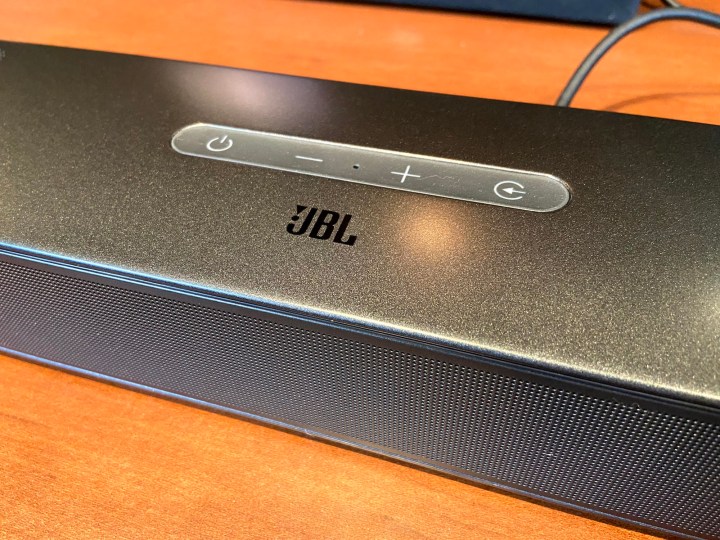
Around the back of the JBL Bar 5.0 Multibeam, you’ll find a USB port that can be used for music playback from hard drives or flash drives. It also pumps out 5 volts at 5 milliamps, which might just be enough to power a streaming stick like an Amazon Fire TV Stick or a Roku device.
You’ll also need to use the USB port for doing firmware updates. Given that the soundbar can connect to Wi-Fi and Bluetooth, I don’t know why JBL forces you to use the USB port, but I guess you can’t have everything at this price.
There’s an optical input and a pair of HDMI ports. This is a nice touch: Far too many soundbars require that you give up one of your TV’s HDMI ports for their HDMI ARC or eARC connection, and they don’t provide an HDMI input to make up for it.
The Bar 5.0’s HDMI input can passthrough 4K and Dolby Vision HDR, which is exactly what you’ll need if you want to connect a streaming media device that can accommodate these video formats.
As I indicated above, the soundbar can connect to Wi-Fi (2.4 and 5GHz bands), and it has Bluetooth 4.2 for receiving audio streams from a phone, tablet, or other Bluetooth devices.
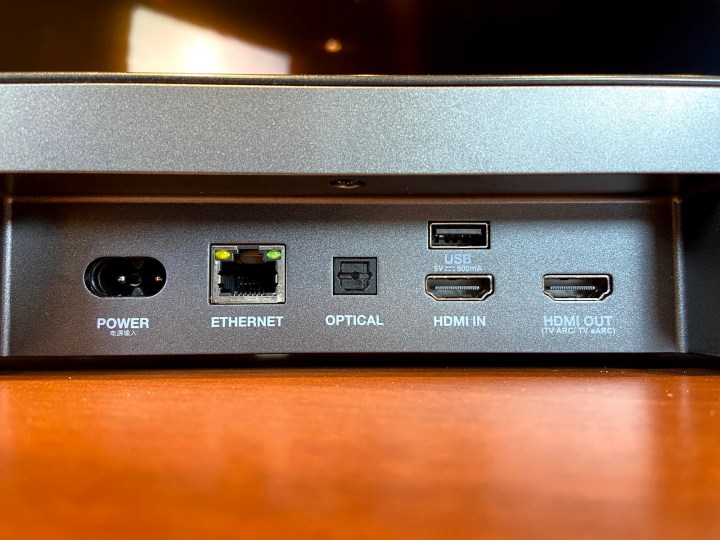
Using these wireless capabilities is entirely optional and won’t affect the Bar 5.0’s basic functionality in any way. JBL doesn’t make a smartphone app for this soundbar, so even if you do set up Wi-Fi, it won’t give you any extra settings or controls.
Getting going with the Bar 5.0 couldn’t be easier.
However, I do strongly recommend setting up Wi-Fi, as it offers far better sound quality for music streaming than Bluetooth. More on that later.
If your home Wi-Fi isn’t especially good, or you happen to have an Ethernet cable nearby, there’s an Ethernet port, too.
Setting up
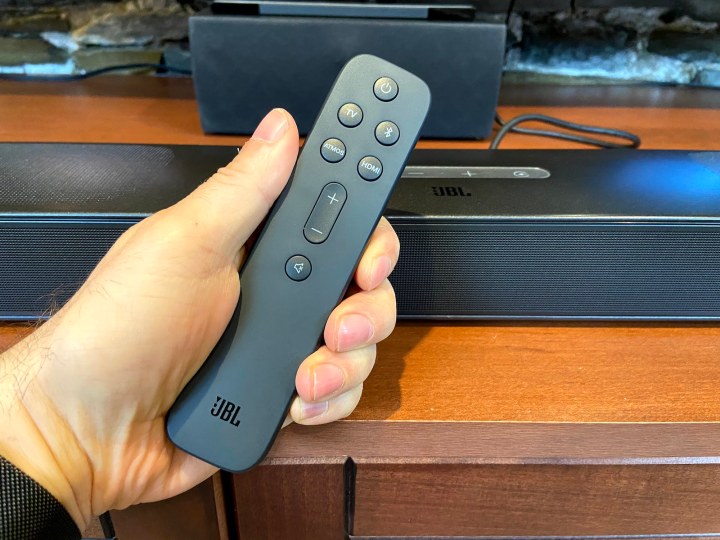
Getting going with the Bar 5.0 couldn’t be easier. Plug it into your TV’s HDMI ARC or eARC port with the included HDMI cable, then plug it into a power outlet, and you’re done. If your TV doesn’t support HDMI ARC, you’ll need to buy an optical cable. If you go the optical cable route, keep in mind that you’ll be limited to Dolby Digital 5.1 audio from your TV, because Dolby Atmos isn’t compatible with optical connections.
JBL has designed the Bar 5.0 to be compatible with all three major wireless smart home ecosystems, which is brilliant.
But don’t be too alarmed: If you plug an Apple TV 4K, Amazon Fire TV Stick 4K, or any other streamer that supports Dolby Atmos into the soundbar’s HDMI input, you can still get Dolby Atmos sound — you simply won’t get it from any sources that are plugged into your TV directly.
Chromecast, AirPlay, and Alexa

JBL has designed the Bar 5.0 to be compatible with all three major wireless smart home ecosystems, which is brilliant. Better yet, you aren’t forced to choose one; the soundbar can be added to Google Home, Apple Home, and the Alex app, and you can switch back and forth between all three if you choose. Most folks will pick just one.
I found it only took a minute or two to add the Bar 5.0 to Google Home so that I could use Chromecast, and setting it up as an AirPlay 2 speaker took only seconds.
Going through this process is easy and totally worth it for the improved audio quality but it’s also very handy if you already own a smart speaker. The Bar 5.0 won’t let you talk to Alexa, Siri, or Google Assistant, but it can be controlled by all three if you have another way to issue voice commands.
Sound quality
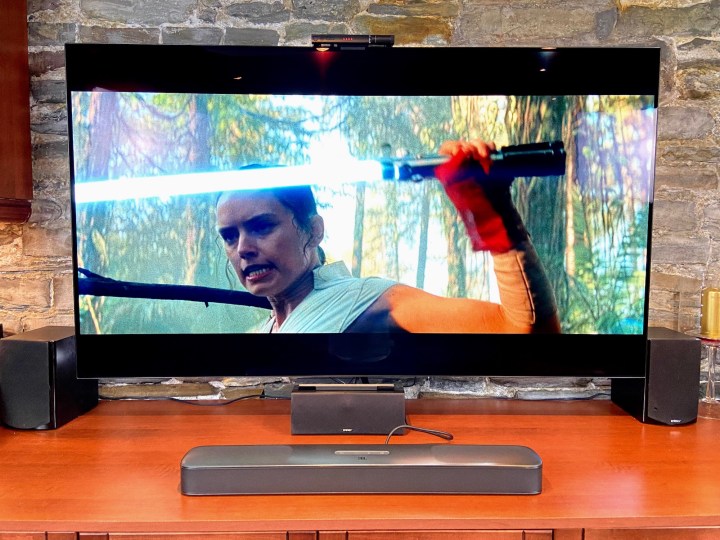
The JBL Bar 5.0 Multibeam delivers clear, well-balanced sound that can easily fill a medium-sized bedroom or living space. A simple and easy room calibration function lets the soundbar adjust its settings to match your room’s specific acoustic properties.
Unfortunately, even though you can adjust the Bar 5.0’s bass properties, there are no other EQ settings for the treble or midranges.
But while it’s miles better than your TV speakers, the lack of a dedicated subwoofer means you may need to keep your expectations in check.
All things considered, the bass response is very good. You can adjust the amount of bass via a five-level setting, but even at level five, you won’t get the kind of rumbling low end that we tend to associate with dedicated home theater systems.
It’s not a deal breaker by any means. There’s still more than enough power in the low end to enjoy action movie soundtracks. It can even surprise you at times: In an early scene in Star Wars: Episode IX — The Rise Of Skywalker, Kylo Ren has his first meeting with Emperor Palpatine. Palpatine’s voice resonates with otherworldly power and seems to come from all around the room. It’s thrilling and lets you believe that Ren might just be a little intimidated by Palpatine’s menacing presence despite his show of bravado.
Unfortunately, even though you can adjust the Bar 5.0’s bass properties, there are no other EQ settings for the treble or midranges. Likewise, there are no preset sound modes for movies, music, speech enhancement, or nighttime, which have become fairly standard on the newest soundbars.
As a result, the louder you push the volume, the more shrill the higher frequencies become, and there’s not much you can do to fine-tune it. I found level 19 on the volume scale to be the sweet spot. It’s loud enough to really immerse you in the content, without getting painfully sharp in the highs.
One of the Bar 5.0’s highlight features is its support for Dolby Atmos. Technically speaking, it uses Virtual Dolby Atmos, which means that instead of possessing up-firing drivers that bounce Atmos’ signature height channel sounds at you, the soundbar’s five racetrack-style drivers combine to create a simulated height effect.
No, it’s not as effective as a dedicated Dolby Atmos soundbar like the Sonos Arc, but you can definitely tell the difference, especially when you toggle the Virtual Dolby Atmos processing on and off using the remote.
With Virtual Atmos on, the soundstage becomes wider and taller. Sounds don’t quite zip around the room the way they would with dedicated Atmos speakers, but it really is a more immersive experience than you’d get with a non-Atmos-capable soundbar.
Speaking of Atmos, I strongly recommend finding a way to stream Dolby Atmos Music to the Bar 5.0. This is easiest when using an Apple TV 4K. Not only does the Tidal app deliver Atmos Music (if you subscribe to Tidal’s HiFi tier), but soon, the Apple Music app will do the same.
And listening to Dolby Atmos Music tracks is a joy.
As an experiment, I played The Weeknd’s Blinding Lights four ways using Tidal: First with Bluetooth, then with Chromecast, then with AirPlay, and finally a Dolby Atmos Music version via the Apple TV 4K.
Over Bluetooth, the track sounded thin and even a bit tinny. I found this was true of all Bluetooth streams regardless of the source. Chromecast introduced a big bump in quality, and I could hear the full range of the song. AirPlay actually sounded better still. But the most satisfying version was the Dolby Atmos Music mix, which took full advantage of the soundbar’s immersive capabilities.
When chilling on the couch listening to your favorite tunes, it’s hard to beat a Dolby Atmos mix.
Our take
The JBL Bar 5.0 is well-priced and has a great set of useful features. It lacks the ability to adjust its EQ, and it can’t compete with systems that have dedicated subwoofers, but I think most people will love the way it adds an extra dimension to their movies and music, especially when presented in Dolby Atmos.
Is there a better alternative?
If you want a more thrilling Dolby Atmos experience, the Vizio M-Series 5.1 multi-speaker soundbar is worth a look. It’s the same price ($350) as the JBL, but it has several components to place around your room, making it a little less convenient. It also lacks Chromecast, AirPlay, and Alexa compatibility.
If Dolby Atmos isn’t as important to you, the slightly more expensive Bose Smart Soundbar 300 offers higher-quality sound, especially for music, and has the added benefit of working as an Alexa or Google Assistant smart speaker.
But if you want the simplicity of a single speaker with many of the benefits that Dolby Atmos offers (and a wealth of connection options) ,we have yet to find a soundbar that can deliver what the Bar 5.0 Multibeam offers at the same price.
How long will it last?
JBL makes a quality product, and I expect the Bar 5.0 Multibeam will last as long as you need it to. The ability to update its firmware is also a good indicator that JBL will keep its smart features alive for many years to come.
Should you buy it?
Yes. As a simple solution for much better TV sound for small-to-medium-sized rooms, the JBL Bar 5.0 Multibeam is a very solid choice.
Editors' Recommendations
- Sony’s best soundbars are reborn as the Bravia Theater Bar 8, Bar 9, and Quad
- TCL goes all-in on Dolby Atmos with its first 7.1.4-channel soundbar
- The best Dolby Atmos soundbars for 2023
- Sennheiser’s Ambeo Soundbar Mini is a pricey, bedroom-sized Dolby Atmos speaker
- Samsung adds HW-Q900C to its lineup of 2023 Dolby Atmos soundbars



